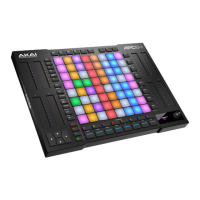63
5.8.1 CV Connection Examples
The following examples describe how to connect the CV/Gate outputs on your APC64 to an external device such
as a modular or semi-modular analog synthesizer with CV/Gate inputs. In these examples, APC64 will connect to
the Moog Music Mother-32 semi-modular analog synthesizer, but the instructions can apply to any device with
comparable connections.
5.8.1.1 Standalone Connections
First, set up pitch and gate control to send note information from APC64 in standalone mode to your device.
1. In the 5.6 Global Menu, set the CV1 Source option to Pitch-Last. This will send pitch information (such
as notes being played in Note Mode) to your device. Since the CV output is monophonic, the pitch will
change each time a new note is received when set to Pitch-Last.
2. Next, set the CV2 Source option to Gate-Last. This will trigger a new note on message each time a new
note is played.
3. Connect the CV1 output to your external CV device. This will usually be connected to a VCO input; in this
case, connect to the VCO 1V/OCT input on Mother-32.
4. Connect the CV2 output to your external CV device. This will usually be connected to a Gate input; in this
case, connect to the Gate input on Mother-32.
5. Enter Note Mode on APC64 and begin playing the pads. Your external device should begin responding
to each new note event.
For even greater note control, you can continue by setting up Veloctiy and Aftertouch.
1. In the 5.6 Global Menu, set the CV3 Source option to Velocity-Last. This will send velocity MIDI data to
your device each time a new value is received.
2. Next, set the CV4 Source option to Aftertouch. This will send send poly aftertouch MIDI data to your
device.
3. Connect the CV3 output to your external CV device. This will usually be connected to a VCA or Velocity
input; in this case, connect to the VCA CV input on Mother-32.
4. Connect the CV4 output to your external CV device. This will usually be connected to ome kind of
modulation input; in this case, try connecting to the VCO Mod input on Mother-32 to use aftertouch to
control the amount of modulation applied to the signal.
5. Enter Note Mode on APC64 and begin playing the pads. Your external device should now respond to
velocity and aftertouch messages.
Next, try setting up fader control to use APC64’s touch faders to control other parameters on your device.
1. In the 5.6 Global Menu, set the CV5 Source
option to Fader 1. This will send data from APC64’s Touch
Fader 1 to your device.
2. Connect the CV3 output to the CV input of the external device parameter that you want to control. In this
case, connect to the Mix CV input on Mother-32, allowing you to use the fader to crossfade between the
VCO waveform and external audio/white noise.
3. As you move your finger up and down the touch fader, the fader’s values will be converted by APC64 and
sent to your external CV device to control the selected parameter.
Note: You can customize the CC number, range, and behavior of the touch fader using the APC64 Project Editor
Software to further customize fader control. For instance, in the example above you could set the Fader Style to
Pan so that the fader begins at the midpoint of the Mix control and can be moved up or down to adjust the mix
balance.

